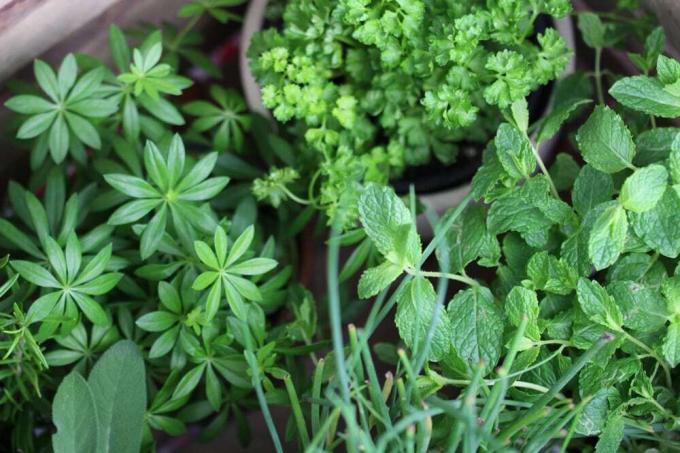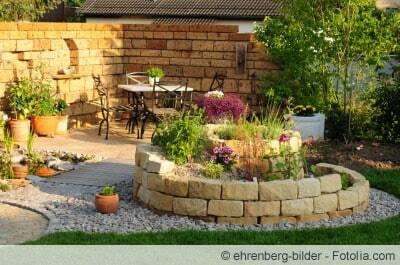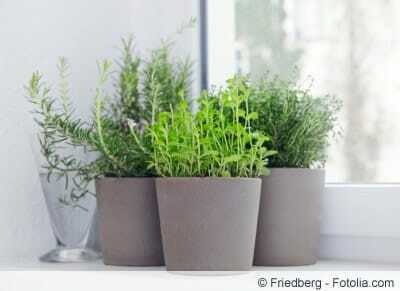

Table of contents
- Preparation
- First steps
- The planting
- Suitable plants and herbs
- The pros and cons
- Conclusion
A herb bed on the terrace or balcony for direct use in the kitchen or tasty tomatoes here Setting accents is what every hobby gardener, who may only have limited space in a small corner, wants has. A mortar tub is the ideal planter that fits in many corners, can be used as a small raised bed and is therefore also a nice eye-catcher. Mortar tubs are available in a variety of sizes and shapes at any hardware store and can be spiced up a bit before planting.
Preparation
As always with such projects, the planning is the starting point. First of all, the available space must be measured and one or more mortar tubs of appropriate size must be purchased. Mortar troughs are offered in round or rectangular with different capacities. You can choose between a capacity of 12 liters up to 40 liters. The following must also be provided for the bed:
- Styrofoam, old packaging can be used for this
- Expanded clay from hydroponics
- sand
- enough soil
- Depending on what is to be planted, for example herbal soil, potting soil or garden soil
- according to the soil used compost to mix in
- plant fleece
- Cladding, for example roof battens
- Wood color according to your own taste
required materials
- cordless drill
- hammer and nails
- Paint brush
Tip:
If the mortar tub is placed on a mobile base before being filled with soil, it can be moved to another location at any time, for example from the terrace to a terrace for the winter Garage. The bucket rollers for planters are suitable for round tubs, for rectangular tubs a rectangular pedestal with casters, which are sold in hardware stores, can be used to move heavy furniture postpone.
First steps

The mortar trough must be prepared before the earth can be poured in. For this purpose, holes are made around the lower edge of the side panels. Pay attention to equal distances and drill about five to six holes. In this way, the excess irrigation water can drain off. Then the bucket is placed on the bucket roller. Break the styrofoam into small pieces and place on the bottom of the tub. Alternatively, Lecaton (expanded clay), stones or larger pebbles can be used as drainage. Then proceed as follows:
- The plant fleece is placed on top of this so that the soil cannot clog the drainage
- Mix soil with sand and lecaton or gravel to make it more permeable
- if no special soil from the trade is used, also mix in some compost
- Fill in the soil to just below the rim of the tub
- cut the roof battens to the appropriate bucket height
- paint with the chosen color
- place around the mortar tray, connecting the wood with cross braces
- make sure that the mortar pan is not damaged on its side walls
- otherwise water will leak out later and the wooden border will swell
The planting
After the mortar tub has been prepared and completed, the desired plants and herbs can move in. Since cultivation in a mortar tub is primarily a small raised bed, Of course, all plants that are also suitable for such a raised bed are suitable for this bed. In addition, there is the chosen location, depending on whether it is very bright and very sunny or rather in the shade has been selected, the appropriate herbs, vegetables or flowering flowers and shrubs must be selected become.
It should also be considered before planting which plants are annuals and which are perennials. Because these should not be mixed in a bucket. Tomatoes, peppers and other vegetables are annuals and can therefore be cultivated together in one pot. Perennial herbs, on the other hand, are planted together in another tub. The growth height must also be taken into account. The large plants are placed at the back against the wall, the smallest are placed at the front. Additional questions before planting should be asked as follows:
- the herbs and plants should be used primarily for the kitchen
- herbs are needed for various healing methods
- or should only fragrant and decorative plants be cultivated
Tip:
If there is enough space and different types of plants and herbs are to be cultivated, it is a good choice If you like, several mortar tubs of different sizes and shapes together or in different corners arrange.
Suitable plants and herbs
Many different herbs and plants can be cultivated for the bed in the mortar tub. But as already mentioned, the plants in a bed should always fit together. But even those herbs and plants that have the habit of spreading quickly are better suited for planting in tubs than for planting in garden beds. These include, for example, lemon balm, mint or oregano. Due to the natural stop of the side walls, there is no unhindered expansion. The following herbs and plants, among others, are suitable for cultivation in a mortar tub:
- chives
- rosemary
- thyme
- lovage
- tarragon
- sage
all of which belong to the perennial herbs.

Vegetable plants that can be cultivated in a pot or tub and therefore also in a mortar trough are:
- Tomatoes, they like it sunny but not rain and are therefore ideal on a covered but sun-drenched terrace
- paprika
- eggplants
- Cucumbers, however, need to be tied up
- Carrots, as their height in the mortar trough gives them enough opportunity to grow down into the earth
- the same applies to radishes, radishes and other root vegetables
Tip:
Anyone who does not have their own garden but has a terrace or balcony can cultivate almost any vegetable and herb as well as decorative plants in the mortar tub. Above all, the attempt makes you smart here. If the cultivation of one vegetable does not work, then something else is grown the next year.
The pros and cons
Many hobby gardeners shy away from using mortar tubs, especially for plants that are later to be used in the kitchen. This is because mortar tubs give off an odor that some people find unpleasant when they are new. Therefore, many assume that this cannot be good for the cultivated herbs or plants either. But you can calm down here, because it looks like this:
- Mortar troughs are made of polyethylene or polypropylene
- these substances do not contain any plasticizers that could be released into the soil and thus be absorbed by the plants
- The smell of the mortar tubs comes from the filler, which consists of soot, among other things
- this is not harmful to plants, including those used in the kitchen
- the smell is not recognizable and perceivable for everyone
- Odor dissipates immediately when the mortar pan is filled with earth and covered from the outside
- Mortar pans are very inexpensive to purchase
- In this way, there is no need for balcony boxes, which usually do not have sufficient depth for the herbs
- If you use mortar tubs, you can create beautiful raised beds for the balcony or terrace in a short amount of time
Tip:
If you want to be absolutely sure, water the buckets for a few days before using them for the first time, then you should any existing toxins are transferred to the water and the use of the mortar tub is therefore harmless be. The smell also dissipates faster this way.
Conclusion
Mortar tubs are an ideal alternative to a homemade wooden herb bed or the much smaller flower boxes. Because they are available in many different sizes, are relatively inexpensive despite their size and can quickly be converted and embellished to become an eye-catcher on the balcony or terrace. For example, they can be covered with colorful roof battens, so that the simple plastic bucket is no longer visible. In this way, even in the smallest corner there is space for a small herb garden, tomatoes, peppers and other vegetables, and blooming flowers or shrubs can also be cultivated. Almost every plant can find its place in a mortar tub, because this is also well suited for deep-rooted plants or root vegetables due to its depth.
 garden editorial
garden editorial I write about everything that interests me in my garden.
Learn more about herb garden

Build your own herb bed: ideas for classic and modern beds
Herbs from the garden are a welcome and totally trendy thing. They are tasty and healthy as well. So it makes sense to build a herb bed. That can then also be designed in a modern way. There are ideas for this here.

Perennial herbs in the herb garden - list of hardy varieties
Herbs are very popular among hobby gardeners, and rightly so! Because the plants are not only versatile, but also usually perennial and hardy! You can find out here which varieties you should definitely grow in your herb bed!

The best two herb snail building instructions
From the dry zone to the swamp area, the right climate zone for every herb. All of this in just three square meters. With a herb snail, you can create this small natural wonder, a so-called permaculture, in your own garden. There are multiple varieties and appearances and sizes, all of which follow basically the same building instructions.

Creating a herb snail – instructions in 6 steps
With a herb snail, fresh kitchen herbs are always on the table, and they also have a high decorative value in the garden. The attractive herb bed in the form of a spiral grows upwards like a snail and therefore allows the planting of many different herbs with different demands on each Location.

Lavender varieties - hardy species for the garden
Robust, strongly scented and used in the kitchen and as a remedy, everyone knows lavender. But be careful, because not all of the many varieties of lavender are suitable for cultivation in your garden bed at home. Because there are only a few varieties that are hardy and can survive a winter in the local latitudes outside.

Grow herbs and spices in the apartment/kitchen
Herbs and spices can also be easily grown in the home or in the kitchen if there is no garden available for cultivation. However, additional effort must be planned for maintenance. The site conditions are just as important here as in the herb garden, so that the herbs can thrive.
